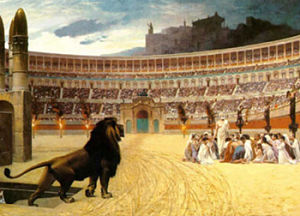Martyrdom in the Early Church
Right from the beginning martyrdom was a feature of the Christian Church’s life. From St Stephen, the First Martyr, and with the martyrdom of the Apostles, many Christians paid the ultimate price for their fidelity to Jesus. Facing death the Church and her martyrs saw a participation in the death of Jesus and went to their deaths, some in dreadful circumstances, with joy in their hearts trusting in God. Following the first persecution under the Jews in which St Stephen and St James died, the Roman authorities were not inclined to tolerate Christianity. The Romans would have accepted Jesus as a god among their pantheon of gods, but when the Christians insisted that there was only one God, fearing the first flicker of a possible rebellion the Romans instigated a series of persecutions. Nero was responsible for the first serious persecution, blaming the Christians for the fire of Rome in 64 AD. SS Peter and Paul died in this persecution as the emperor first brought the Christians into the arena to be killed in the games. From then on persecutions were sporadic throughout the empire and many senior Church figures were put to death, among them St Ignatius, Bishop of Antioch, St Polycarp, Bishop of Smyrna and most of the Popes until the third century.
In the year 235 AD, following a long peace, the emperor Maximin instituted another serious persecution of Christianity in which, among many, one of our famous martyrs St Cecilia the Virgin martyr, died. Under the emperor Decius (249-251) a systematic persecution began in 250 and all citizens and subjects of the empire had to carry a libellius (certificate)to show that they offered sacrifices to the gods: those who did not have the libellius or would not offer sacrifice were put to death. Under the emperor Valerian (253-260) the great theologian St Cyprian was among those martyred for the faith.
The worst was yet to come. In 285 Diocletian became emperor and began a major remodeling of empire. In 303 at a sacrifice offered by Diocletian and the emperor of the eastern empire, Galerius, the pagan priests could not discern the signs they expected to see on the animals’ livers. Consulting the oracle of Apollo at Miletus, Diocletian was informed that Christians were to blame. On 23rd February he issued an edict for the Christian cathedral opposite the Imperial palace in Nicomedia to be razed to the ground, beginning was to be the fiercest persecution of Christians to date. Among the numerous Christians who were martyred were SS Sebastian, Maurice, George, Agnes, Lucy, Catherine of Alexandrina and of course St Genesius. Indeed most of the Roman martyrs suffered at this time. The persecution finally came to an end when the Emperor Constantine issued his Edict of Milan in 313 which guaranteed religious freedom.
Life under the persecutions was difficult. Christians went about their daily lives as best they could, gathering every Sunday for the Mass in various house churches. They buried their dead in the catacombs, giving pride of place to those who had been martyred and honouring them each year with a special Mass at the tomb on the day of the martyr’s death (the future feast day). When the emperor Constantine converted to Christianity in 325, Christianity began to play an important part in the life of the empire; basilicas and churches were built and the remains of the martyrs (relics), now recognised as saints, were exhumed and placed in altar tombs for the veneration of the faithful.
Since Roman times, there have been many bouts of persecution. The period of the Reformation in England and Ireland saw many killed for their Christian faith, and the French Revolution unleashed a vicious attack on Christians – hundreds of Catholics, priests, religious and lay either were put to death by guillotine or in other brutal ways as the authorities sought to establish the Cult of Reason. The fiercest period of persecution in the Church’s history to date, however, has in fact been the most recent: the persecutions of the 20th century. Thanks to Marxism and Socialism alone in China, Mexico, Republican Spain, the Soviet Union and her empire and various régimes in Africa, Christian martyrs can be counted in terms of millions. In Spain alone Republicans are known to have martyred 8,000 priests and religious and at least 80,000 Catholic men, women and children: all innocent people who were murdered because they were Catholics. In China following the Cultural Revolution under Mao Tse Tung, a huge number of Christians were put to death and many more imprisoned: the exact number of those martyred is yet unknown, but it is expected to vastly exceed those martyred in Spain. Martyrdom continues today in Africa, Asia and in the Middle East where Christianity is either banned or barely tolerated.
© The Fraternity of St Genesius 2007



Praying for those involved in cinema and theatre
